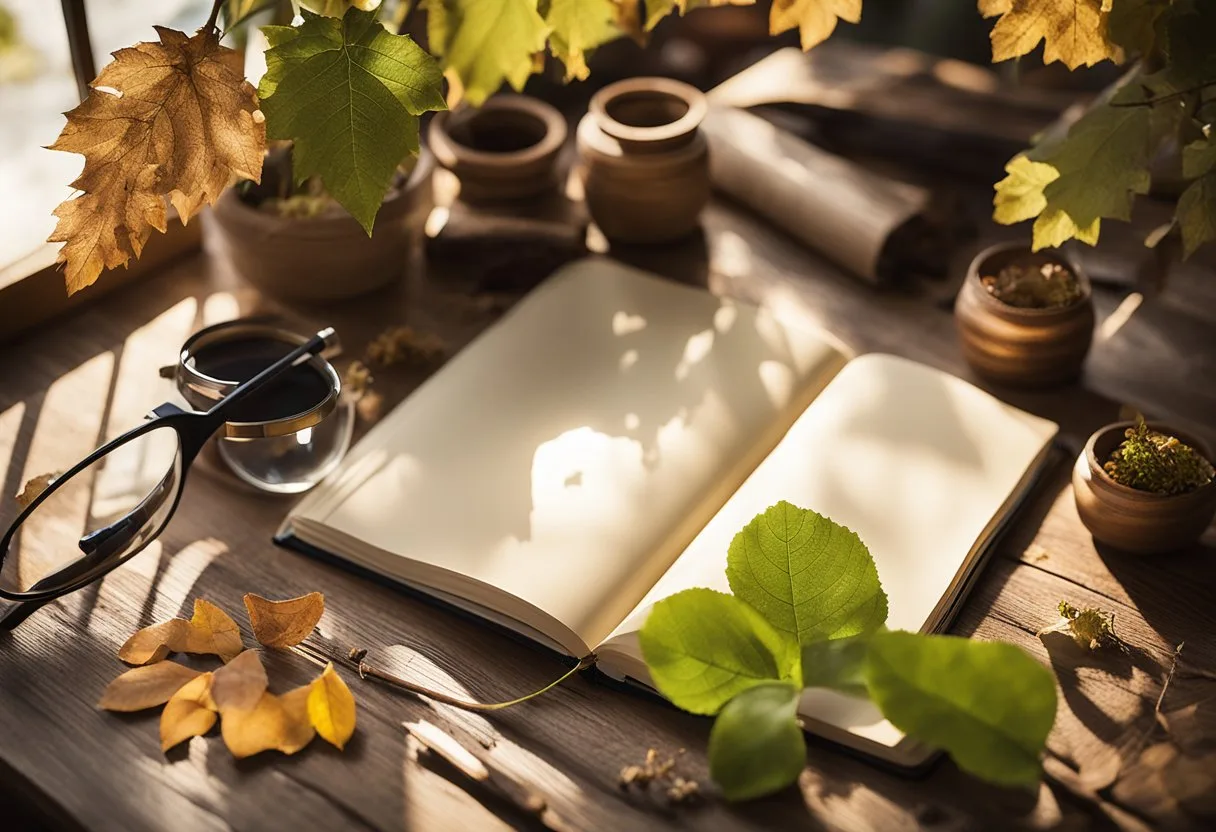Creative journaling is a practice that combines the benefits of writing with the freedom of artistic expression. It is a tool that can be used to explore one’s inner thoughts and feelings, generate new ideas, and enhance creativity. Creative journaling is a great way to unwind, de-stress, and boost mental health. It can also help improve planning, organization, and problem-solving skills.
Journaling has been around for centuries, and people have used it to record their daily experiences, thoughts, and feelings. Creative journaling takes this practice to the next level by incorporating art, music, and other forms of self-expression. It allows individuals to explore their creativity in a safe and non-judgmental environment. By combining writing and art, individuals can tap into their imagination and generate new ideas.
What is a Creative Journal?
A creative journal is a bound notebook or digital space that serves as a personal canvas for self-expression and exploration through various forms of creativity. Unlike traditional journals that may focus on written entries of daily activities or thoughts, creative journals encompass a broader range of artistic expression. They can include sketches, collages, paintings, poetry, short stories, mixed media, and even ephemera such as ticket stubs or pressed flowers.
Creative journals are unique to each individual, reflecting their interests, emotions, and artistic journey. They are not restricted by rules or guidelines; instead, they encourage freedom and imagination.
This type of journal can be especially appealing to those who think visually or wish to explore their thoughts and feelings through art. It allows for the integration of color, texture, and form in a way that words alone may not fully capture.
For many, the act of creating within the pages of a journal is a meditative and therapeutic process. It can serve as a form of stress relief, providing a safe space to escape from the pressures of daily life. Creative journals act as a visual diary, holding a tangible record of personal growth, ideas, and inspirations.
They are often kept private, giving the creator the liberty to be vulnerable and honest without the fear of judgment. The versatility and personal nature of a creative journal make it an invaluable tool for nurturing one’s creativity and preserving moments of inspiration.
Purpose of a Creative Journal
The purpose of a creative journal is multifaceted, serving as a repository for the imagination and a sanctuary for the mind. One of its primary functions is to provide a platform for self-expression. It allows individuals to communicate inner thoughts, feelings, and ideas that they may not be able to articulate verbally. Through various artistic mediums, journalers can explore their emotional landscape, often leading to personal insights and emotional catharsis.
Another purpose of a creative journal is to foster artistic growth. It is a place to practice and hone artistic skills without the pressure of perfection. By experimenting with different techniques and materials, individuals can discover their preferences and develop their unique style. The journal becomes a record of progress over time, showcasing the evolution of one’s artistic abilities and creative thinking.
Creative journals also serve as a tool for inspiration and motivation. They can be filled with quotes, images, and other stimuli that spark creativity. When facing a creative block, flipping through past pages can reignite the imagination and provide a springboard for new projects. Setting aside time to work in a creative journal can help establish a regular creative practice, ensuring that time is dedicated to nurturing one’s artistic endeavors.
Lastly, a creative journal can act as a historical record, capturing the zeitgeist of one’s life. It can include reflections on current events, personal milestones, and the everyday moments that might otherwise be forgotten.
This archival aspect provides not only a sense of accomplishment and a way to look back on one’s journey but also a physical legacy of one’s creative life. Whether for personal satisfaction or as a keepsake to share with others, the creative journal is a powerful testament to the human capacity for creativity.
How to Start a Creative Journal: step by step guide.

Starting a creative journal is a wonderful way to express yourself and document your artistic journey. Here’s a step-by-step guide to help you begin your own creative journaling practice:
- Choose Your Journal: Select a journal that inspires you. This could be a sketchbook with quality paper that can handle different media or a simple notebook that feels good to the touch.
- Gather Your Materials: Assemble a variety of writing and art supplies that you enjoy using. These can include pens, pencils, markers, paints, collage materials, and anything else that sparks your creativity.
- Create a Comfortable Space: Find a spot where you feel relaxed and free from interruptions. Having a dedicated space can help you get into the right mindset for creativity.
- Set Aside Time: Decide on a regular time to work in your journal. Whether it’s a few minutes each day or a longer session once a week, consistency will help you build a habit.
- Start with a Warm-Up: Begin your journaling session with a quick creative exercise, like doodling or writing a stream of consciousness, to get your creative juices flowing.
- Use Prompts: If you’re unsure what to create, use prompts to inspire your work. Prompts can be visual, written, or thematic to kickstart your imagination.
- Experiment with Techniques: Don’t be afraid to try new artistic techniques or combine different media. Creative journaling is about exploration and discovery.
- Embrace Imperfections: Your journal is a safe space for experimentation, so don’t worry about making mistakes. They’re part of the creative process.
- Include Personal Reflections: Alongside your creative expressions, write about your thoughts, feelings, and the stories behind your artwork.
- Review and Reflect: Regularly look back at your previous entries. This can help you see your progress, notice patterns in your work, and gather ideas for future creations.
- Keep It Private: Knowing your journal is just for you can give you the freedom to express yourself fully without fear of judgment.
- Stay Inspired: Keep your creativity flowing by seeking inspiration from the world around you—nature, art, music, books, or anything else that sparks your interest.
- Be Patient with Yourself: Creativity can ebb and flow. Be kind to yourself if you’re experiencing a block and remember that the process is just as important as the end result.
Getting Started with Creative Journaling
Creative journaling is a great way to express oneself and document life experiences. It can help one to develop a habit of writing, organize thoughts, and plan for the future. Here are some tips to get started with creative journaling.
Choosing the Right Journal
Choosing the right journal is an important step in starting a creative journal. The journal should be of a size that is comfortable to write in and carry around. It should also have a cover that inspires creativity and suits one’s personal style. A journal with blank pages is recommended for those who want to draw or sketch in their journal, while lined pages are better for those who prefer to write.
Essential Supplies
Apart from the journal, there are a few other essential supplies that one may need to get started with creative journaling. These include pens, pencils, erasers, markers, and stickers. One may also want to invest in a ruler and a protractor for drawing straight lines and angles.
It is important to note that while supplies can be helpful in enhancing creativity, they are not necessary. One can start with just a pen and a journal and still create meaningful entries.
In addition to these tips, one can also find creative ideas and journal prompts online to help get started. It is important to remember that the goal of creative journaling is not to create a perfect work of art, but rather to express oneself and document life experiences. With practice and consistency, creative journaling can become a fulfilling and enjoyable habit.
Journaling Techniques and Exercises

Journaling is a powerful tool to unlock creativity and boost productivity. There are several techniques and exercises that one can use to get started with journaling. In this section, we will discuss a few of them.
Freewriting and Brainstorming
Freewriting is a technique that involves writing without any specific goal or agenda. The writer writes continuously for a set period, without worrying about grammar, spelling, or punctuation. This technique helps to overcome writer’s block and generate new ideas. Brainstorming, on the other hand, involves listing down all the ideas that come to mind, without evaluating them. This technique helps to generate a large number of ideas in a short period.
Mind Mapping and Lists
Mind mapping is a visual technique that involves mapping out ideas in a diagram. The central idea is placed in the center, and related ideas are connected to it using branches. This technique helps to organize ideas and identify connections between them. Lists are another technique that involves listing down ideas, thoughts, or tasks in a structured manner. This technique helps to keep track of ideas and tasks and prioritize them.
Creative Writing Prompts
Creative writing prompts are a great way to get started with journaling. They are specific prompts that are designed to inspire creativity and help writers generate new ideas. Some examples of creative writing prompts include “Write about a childhood memory that still haunts you,” “Describe your dream vacation destination,” and “Write a letter to your future self.
Journaling is a powerful tool that can help to boost creativity and productivity. There are several techniques and exercises that one can use to get started with journaling, including freewriting, brainstorming, mind mapping, lists, and creative writing prompts. By incorporating these techniques into their journaling practice, writers can unlock their creativity and generate new ideas.
Incorporating Art and Imagination

Art journaling is a creative way to document one’s life experiences, thoughts, and emotions through a combination of writing and visual art. Incorporating art and imagination into the journaling process can help one to express themselves in unique and meaningful ways.
Art Journaling Basics
To get started with art journaling, one needs to have a journal or notebook, along with some basic art supplies such as pens, pencils, markers, and paints. One can choose to use a blank journal or one with pre-printed pages, depending on their preference. The goal is to create a space where one can freely express themselves without any limitations.
Doodling and Sketching
Doodling and sketching are great ways to incorporate art into one’s journaling practice. It allows one to express their thoughts and ideas visually, without the need for words. One can doodle or sketch anything that comes to mind, whether it’s a simple shape or a complex design. It’s a great way to let one’s imagination run wild and create something unique.
Collage and Mixed Media
Collage and mixed media are other ways to incorporate art into one’s journaling practice. Collage involves cutting and pasting images from magazines, newspapers, and other sources onto the journal pages. Mixed media involves using a variety of art materials such as paint, ink, and paper to create a layered effect. These techniques allow one to create a visual representation of their thoughts and emotions in a unique and creative way.
Incorporating art and imagination into one’s journaling practice can be a fun and rewarding experience. It allows one to express themselves in a way that words alone cannot. With some basic art supplies and a willingness to explore, one can create a visual representation of their life experiences that is both meaningful and unique.
Themes and Inspiration for Your Journal

Keeping a creative journal is an excellent way to explore your thoughts and feelings, and it can be a source of inspiration for your daily life. Here are some themes and ideas to help you get started with your journal:
Seasonal and Adventure Themes
One way to keep your journal fresh and exciting is by using seasonal themes. For instance, you can write about your favorite fall flowers, your winter adventures, or your summer memories. This is an excellent way to keep your journal relevant to the time of year and to inspire your creativity.
Another great way to keep your journal exciting is by using adventure themes. You can write about your travels, your favorite animals, or your favorite outdoor activities. This is a great way to keep your journal exciting and to inspire your creativity.
Quotes and Affirmations
Quotes and affirmations are excellent sources of inspiration for your journal. You can use them to inspire your creativity, to reflect on your thoughts and feelings, or to motivate yourself. You can write down quotes that resonate with you or affirmations that inspire you.
Personal Memories and Reflections
Your journal is an excellent place to reflect on your personal memories and experiences. You can write about your childhood memories, your relationships, or your personal growth. This is an excellent way to explore your thoughts and feelings and to inspire your creativity.
Keeping a creative journal is an excellent way to explore your thoughts and feelings, and it can be a source of inspiration for your daily life. You can use various themes and ideas to keep your journal exciting and relevant to your life.
Digital and Alternative Journaling Methods
Digital journaling has become increasingly popular in recent years, with many software and apps available to help people keep track of their thoughts and ideas. One popular digital journal platform is Microsoft OneNote, which allows users to create blank notes that are more like canvases than traditional documents. This app is free and allows users to create bullet points, tables, and other formatting options.
Another popular digital journaling platform is Day One, which is available on both iOS and Android devices. This app allows users to add photos, videos, and audio recordings to their journal entries, making it a great option for those who want to capture their memories in a more multimedia format.
Digital Journal Platforms
Canva is another popular digital journaling tool that allows users to create custom pages and templates for their journals. This platform offers a wide range of design options, including backgrounds, fonts, and graphics, making it a great option for those who want to add a creative touch to their journal entries.
Bullet Journaling and Scrapbooking
For those who prefer a more tactile approach to journaling, bullet journaling and scrapbooking are great alternatives. Bullet journaling involves creating a customized planner or journal using a blank notebook and a series of symbols and icons to represent different tasks and events. This method is great for those who want to stay organized and productive while also expressing their creativity.
Scrapbooking, on the other hand, involves creating a physical book filled with photos, mementos, and other memorabilia. This method is great for those who want to document their memories in a more tangible format and enjoy the process of creating something with their hands.
Whether you prefer a digital or alternative approach to journaling, there are many options available to help you capture your thoughts and ideas in a way that suits your personality and lifestyle.

Frequently Asked Questions
How can I incorporate creativity into my daily journaling routine?
Incorporating creativity into journaling routine can be done in many ways. One way is to include doodles or sketches alongside the text. Another way is to use different colored pens or pencils to highlight important points. You can also try using stickers, washi tapes, or other decorative items to add a personal touch to your journal.
What are some unique prompts to inspire creativity in journal writing?
There are many unique prompts to inspire creativity in journal writing. Some examples include writing a letter to your future self, creating a list of things you’re grateful for, or describing a dream you had in detail. You can also try writing a story based on a picture or drawing, or creating a mind map of your thoughts and ideas.
What materials are commonly used in creating an art journal?
Materials commonly used in creating an art journal include sketchbooks, watercolor paper, acrylic paints, colored pencils, markers, and gel pens. Other materials that can be used include washi tape, stickers, scrapbook paper, and other decorative items.
How does creative journaling differ from traditional diary writing?
Creative journaling differs from traditional diary writing in that it focuses on self-expression and creativity. While traditional diary writing may simply involve recording daily events and emotions, creative journaling encourages the use of different mediums and techniques to explore one’s thoughts and feelings.
Can you provide examples of how to blend visuals and text in a creative journal?
One example of how to blend visuals and text in a creative journal is to use a combination of sketches and written descriptions to record a memorable experience or event. Another example is to use a photograph as a starting point for a written reflection, or to create a collage of images and words that represents a particular theme or idea.
What techniques can enhance creative thinking through journaling?
Techniques that can enhance creative thinking through journaling include mind mapping, free writing, and brainstorming. Another technique is to use prompts or exercises that encourage creative thinking, such as writing a story based on a random object or creating a list of potential solutions to a problem.




